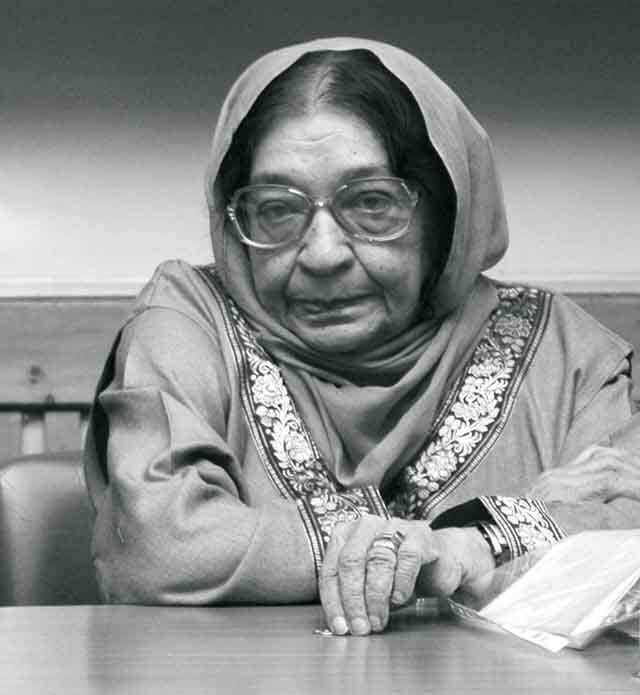Trigger Warning: Mentions of rape, abuse
Surajmukhi Andhere ke (1972) or Sunflowers of the Dark (2008) is a novel by Krishna Sobti about a woman who is haunted by childhood memories of rape years after the incident. Since this novel was written in 1972 (originally in Hindi), the statistics of reported cases of child sexual abuse has risen drastically. The NCRB reported that around 109 children were raped everyday in India in 2018, and even more worldwide. Through Sunflowers of the Dark, Sobti reveals the many ways in which past trauma from sexual violence continues to haunt the victims, and how it is made worse by societal stigmatisation. Ratti is arguably one of Sobti’s strongest female characters; she does not seek to shy away from her situation, but instead chooses to face it head-on.
Plot
The division of Sunflowers of the Dark into ‘Bridge,’ ‘Tunnel’ and ‘Sky’ depicts how her trauma evolves during each phase. ‘Bridge’ introduces the stigmatisation Ratti faces from society which holds her, a child, responsible for an act forced on her against her will. ‘Tunnel’ presents the micro-aggressive comments that added to the event of her trauma. Her trauma evolves to render her independent as she cannot rely on anyone for support, disturbing her encounters with the men. Finally, in ‘Sky,’ in Sunflowers of the Dark Ratti encounters Diwarkar who treats her in a way that no man has so far in her life, with empathy and understanding.
Also read: Book Review: A Gujarat Here, A Gujarat There By Krishna Sobti
Social Stigma
From the start of Sunflowers of the Dark, by saying that Ratti is “Never a girl, [n]ever a woman”, Sobti highlights the limbo-like position that she is left in as she was not able to fully live out her childhood and neither can she cannot fully be an adult. In the aftermath of sexual abuse, women face double-victimisation caused by blame, shame and disbelief. In Sunflowers of the Dark, Ratti does not only resist the actions of her perpetrator, but also the people of her community; her family, friends and peers. Ratti’s friend Reema question her behaviour: “But what is she… who is she fighting?” To which Reema’s husband Keshi replies:, “No one. Just Ratti herself”. Women are urged to ‘move on’ with their lives and not ponder on the incident of their victimisation due to fear of social stigma.
In Sunflowers of the Dark, as a young girl, Ratti realised that according to the society, girls are always at fault. Even her family is not able to empathise with her and provide the support that she needs. Her classmates may not understand the severity of rape, but they know enough of the social stigma surrounded by it to hurl taunts at her:
“YOU’RE NOT A GOOD GIRL”
“SOMEONE DID THE BAD THING WITH YOU”
“YOU BLED. DIDN’T YOU?”
“THE GIRLS ARE RIGHT. YOU ARE A WICKED GIRL.”
“YOU’RE A BAD GIRL!”
“THERE’S BLOOD ON YOUR PANTY, ALWAYS!”
“SHE PREFERS BOYS TO GIRLS.”
“HOW CAN GIRLS GIVE HER WHAT SHE WANTS?”
A women’s goodness is measured against her so-called chastity, which once violated subjects them to double-victimisation. Ratti is first victimised through the act of rape and secondly by unfair social norms. Ratti is labeled “bad” because she was molested in her childhood. In Sunflowers of the Dark, insensitive to her pain, society sadistically stands in an antagonistic position to her because of her ‘ruined’ body, which affects her on a social and psychosomatic level.
Trauma
In Sunflowers of the Dark, the real tragedy of Ratti’s situation is that she is unable to understand how and why she feels the way that she does. The struggles to understand her self because it has been disrupted physically and mentally by the rape. As the reader, we can see that what Ratti is experiencing is trauma; however, as a character, Ratti is unaware of this condition as do many victims.
Studies on trauma have shown that rape can cause physical and psychological pain for long after the incident due to societal ostracisation. In Sunflowers of the Dark, Ratti cannot heal from the incident and instead ends up self-flagellating herself for many years after the rape. As a child she does not posses the mental capacity to deal with the trauma alone. However, she also lacks adult support as rape is something that has socio-historically been a taboo subject to speak about. Despite this, unlike society’s expectation to play the demure victim, Ratti does not exercise her victimhood through silence, but through vocal resistance. She is often violent and “wreak[s] havoc” on those who taunt her. Thus, violence becomes her defense mechanism to deal with repressed trauma. The trauma caused by rape is not a temporary or a momentary occurrence. In Sunflowers of the Dark, Ratti never truly forgets what happened to her, and also society does not allow her to forget.
Also read: Krishna Sobti: Doyen Of Hindi Literature | #IndianWomenInHistory
Ratti is constantly searching for ordinary womanhood which prevents her from pursuing healthy relationships with men. As a result, she unconsciously seeks revenge, by first seducing and then rejecting men. This cataleptic revenge is not simply due to her trauma, but because the men try to control her. All of these men are either married or engaged, they are breaking a moral code. Furthermore, Ratti’s status as an unmarried, financially independent woman subjects her to attempts of conforming her to depend on men. When Rohit tries to assert control over her movement and the company she holds, she asserts: “No. You dare not talk to me like this again, today or on any other day! Where I go and with whom I go is my business, and mine alone!”
In Sunflowers of the Dark, Ratti is fearlessly independent which often seems threatening to the toxic masculinity of the men seeking to control her. As seen in the passage above, Rohit treats Ratti as if he has ownership over her; he also acts as if they are in a relationship whether she knows and accepts it or not. Ratti finds it challenging to form physical relationships with many of the men in the novel, resulting in them calling her “sexually perverted.” Rohit does not ask for her love and companionship; instead, he assumes she feels the same way and demands it. When she resists him he then goes to insult and disrespect her with harsh comments.
Raped as a child, consent is significant for Ratti in Sunflowers of the Dark; thus, Diwarkar asking “I want to make love to you. Will you…?”’, is uplifting for Ratti. By doing so he “successfully rinses out the scar engraved on her psyche” from the rape. Their relationship is based on “equality and mutual respect,” unlike her rapist and Rohit, Diwarkar is not trying to conquer Ratti. Thus, through Diwakar, it cannot be said that Ratti forgets her trauma, but she is able to ‘move on.’ Ratti’s interaction with Diwarkar is actually the only positive sexual relationship with a man she has had.
However, it would be infeasible to attribute their relationship solely to a man-woman sexual relationship. Ratti is drawn to Diwarkar because he is the first person who helps her overcome “the ghosts of her past that continue to haunt her and mar her present.” Her friendship with Diwarkar is positive from the beginning, as he shows genuine interest in her. When they kiss for the first time, Diwarkar notices a “darkness” in her eyes “but no tears”. Unlike, the other men with whom Ratti has had negative encounters, Diwarkar does not mock her hesitation and inhibitions. Not only does he reassure her of his feeling he also asks for consent during intimacy.

Conclusion
Sobti wrote Sunflowers of the Dark at the end of the 20th century, when attitudes towards women in India, though changing, was still very patriarchal. Some feminist discourse may assume that Ratti finding Diwarkar may seem transgressive as her happiness seems to be dictated by a man; however, this is the ‘realistic’ feminist aspect of Sobti’s writing. Ultimately, despite the trauma she experiences, Ratti is a normal human being with desires (sexual or otherwise); however, she does not compromise with her individuality and freedom. Although she encounters many men in her life, men worsen her trauma by seeking to conquer her, and she finally finds Diwarkar who values in Ratti which others did not.
Sunflowers of the Dark focuses only on Ratti’s interaction with the men in her life (except her family and one female friend), and the continuation of the despair she faces because of them in light of her previous sexual trauma. Sobti’s vision of female empowerment has progressed since she first wrote this novel time.
Sunflowers of the Dark focuses only on Ratti’s interaction with the men in her life (except her family and one female friend), and the continuation of the despair she faces because of them in light of her previous sexual trauma. Sobti’s vision of female empowerment has progressed since she first wrote this novel time. Ratti resists the systematic oppression and stigmatisation that women faced in India; however, she does not take away from her core traditional values. She seeks love, a stable marriage, motherhood, and family, but in an egalitarian space where men and women are equals. Furthermore, Sobti’s feminist praxis does not seek to remove women from traditional spaces but to posit them on the same level as men. In a country deeply rooted in culture and tradition, it seems feasible that her approach would be that to reject culture and tradition but by making women active and fundamental participants of it.
References
Krishna Sobti. Sunflowers of the Dark. Translated. Pamela Manasi. New Delhi: Katha (2008)
Radha R. Sharma, Rupali Pardasani, Sharda Nandram. “The problem of rape in India: a multi-dimensional analysis” (2004)
V. Choudhry, R. Dayal, D. Pillai, A. S. Kalokhe, K. Beier, V. Patel. “Child sexual abuse in India: A systematic review” (2018)
Note: This piece has been revised and adapted from my MA essay ‘A Feminist Reading of Krishna Sobti’s Sunflowers of the Dark: The Stigma and Trauma of Rape’.
About the author(s)
Nikhat is a Civil Servant and Communications Manager for BBPC Poetry Collective. Her academic research interests include wartime gender-based violence and intersectional feminist historiography.






